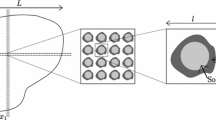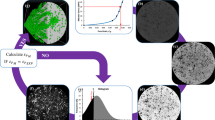Abstract
Homogeneity and heterogeneity are two totally different concepts in nature. At the particle length scale, rocks exhibit strong heterogeneity in their constituents and porosities. When the heterogeneity of porosity obeys the random uniform distribution, both the mean value and the variance of porosities in the heterogeneous porosity field can be used to reflect the overall heterogeneous characteristics of the porosity field. The main purpose of this work is to investigate the effects of porosity heterogeneity on chemical dissolution front instability in fluid-saturated rocks by the computational simulation method. The related computational simulation results have demonstrated that: 1) since the propagation speed of a chemical dissolution front is inversely proportional to the difference between the final porosity and the mean value of porosities in the initial porosity field, an increase in the extent of the porosity heterogeneity can cause an increase in the mean value of porosities in the initial porosity field and an increase in the propagation speed of the chemical dissolution front. 2) An increase in the variance of porosities in the initial porosity field can cause an increase in the instability probability of the chemical dissolution front in the fluid-saturated rock. 3) The greater the mean value of porosities in the initial porosity field, the quicker the irregular morphology of the chemical dissolution front changes in the supercritical chemical dissolution systems. This means that the irregular morphology of a chemical dissolution front grows quicker in a porosity field of heterogeneity than it does in that of homogeneity when the chemical dissolution system is at a supercritical stage.
Similar content being viewed by others
References
BEAR J. Dynamics of fluids in porous media [M]. Amsterdam: Elsevier, 1972: 636.
CHADAM J, HOFF D, MERINO E, ORTOLEVA P, SEN A. Reactive infiltration instabilities [J]. IMA Journal of Applied Mathematics, 1986, 36: 207–221.
CHADAM J, ORTOLEVA P, SEN A. A weekly nonlinear stability analysis of the reactive infiltration interface [J]. IMA Journal of Applied Mathematics, 1988, 48: 1362–1378.
CHEN J S, LIU C W. Numerical simulation of the evolution of aquifer porosity and species concentrations during reactive transport [J]. Computers and Geosciences, 2002, 28: 485–499.
CHEN J S, LIU C W, LAI G X, NI C F. Effects of mechanical dispersion on the morphological evolution of a chemical dissolution front in a fluid-saturated porous medium [J]. Journal of Hydrology, 2009, 373: 96–102.
COHEN C E, DING D, QUINTARD M, BAZIN B. From pore scale to wellbore scale: impact of geometry on wormhole growth in carbonate acidization [J]. Chemical Engineering Science, 2008, 63: 3088–3099.
GOLFIER F, ZARCONE C, BAZIN B, LENORMAND R, LASSEUX D, QUINTARD M. On the ability of a Darcy-scale model to capture wormhole formation during the dissolution of a porous medium [J]. Journal of Fluid Mechanics, 2002, 457: 213–254.
HINCH E J, BHATT B S. Stability of an acid front moving through porous rock [J]. Journal of Fluid Mechanics, 1990, 212: 279–288.
KALIA N, BALAKOTAIAH V. Modeling and analysis of wormhole formation in reactive dissolution in carbonate rocks [J]. Chemical Engineering Science, 2007, 62: 919–928.
KALIA N, BALAKOTAIAH V. Effect of medium heterogeneities on reactive dissolution of carbonates [J]. Chemical Engineering Science, 2009, 64: 376–390.
LAI K H, CHEN J S, LIU C W, YANG S H. Effect of permeability-porosity functions on simulated morphological evolution of a chemical dissolution front in a fluid-saturated porous medium [J]. Hydrological Processes, 2014, 28: 16–24.
ORMOND A, ORTOLEVA P. Numerical modeling of reactioninduced cavities in a porous rock [J]. Journal of Geophysical Research, 2000, 105: 16737–16747.
ORTOLEVA P, CHADAM J, MERINO E, SEN A. Geochemical self-organization II: The reactive-infiltration instability [J]. American Journal of Science, 1987, 287: 1008–1040.
RENARD F, GRATIER J P, ORTOLEVA P, BROSSE E, BAZIN B. Self-organization during reactive fluid flow in a porous medium [J]. Geophysical Research Letters, 1998, 25: 385–388.
SHERWOOD J D. Stability of a plane reaction front in a porous medium [J]. Chemical Engineering Science, 1987, 42: 1823–1829.
ZHAO C, POULET T, REGENAUER-LIEB K. Replacement of annular domain with trapezoidal domain in computational modeling of nonaqaeous-phase-liquid dissolution front propagation problems [J]. Journal of Contral South University, 2015, 22: 1841–1846.
VERMA A, PRUESS K. Thermohydrological conditions and silica redistribution near high-level nuclear wastes emplaced in saturated geological formations [J]. Journal of Geophysical Research, 1988, 93: 1159–1173.
ZHAO C, HOBBS B E, HORNBY P, ORD A, PENG S, LIU L. Theoretical and numerical analyses of chemical-dissolution front instability in fluid-saturated porous rocks [J]. International Journal for Numerical and Analytical Methods in Geomechanics, 2008, 32: 1107–1130.
ZHAO C. Physical and chemical dissolution front instability in porous media: Theoretical analyses and computational simulations [M]. Berlin: Springer, 2014: 354.
ZHAO C. Advances in numerical algorithms and methods in computational geosciences with modeling characteristics of multiple physical and chemical processes [J]. Science China: Technological Sciences, 2015, 58: 783–795.
ZIENKIEWICZ O C. The finite element method [M]. London: McGraw-Hill, 1977: 536.
Author information
Authors and Affiliations
Corresponding author
Additional information
Foundation item: Project(11272359) supported by the National Natural Science Foundation of China
Rights and permissions
About this article
Cite this article
Zhao, Cb., Schaubs, P. & Hobbs, B. Effects of porosity heterogeneity on chemical dissolution-front instability in fluid-saturated rocks. J. Cent. South Univ. 24, 720–725 (2017). https://doi.org/10.1007/s11771-017-3473-1
Received:
Accepted:
Published:
Issue Date:
DOI: https://doi.org/10.1007/s11771-017-3473-1




